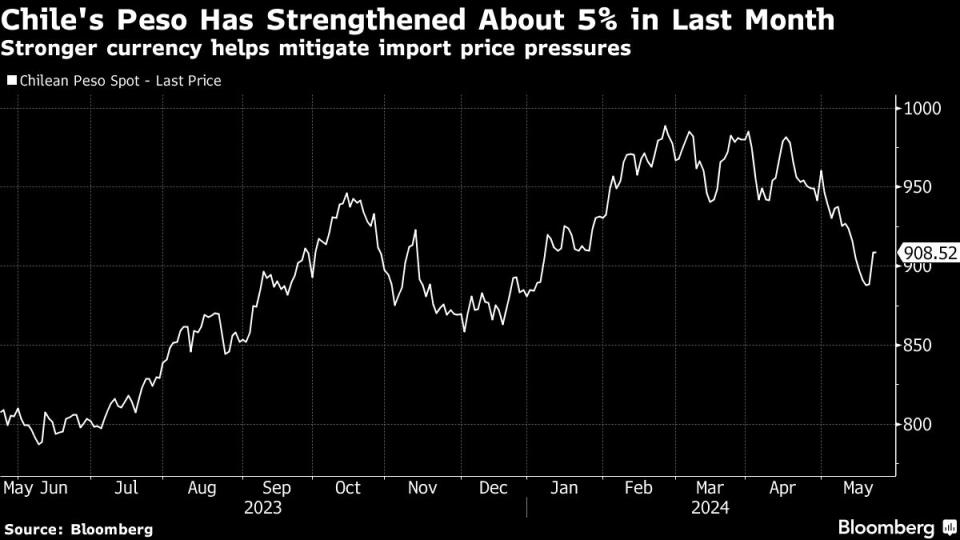Chile Central Bank Slows Easing Pace and Says Further Interest Rate Cuts are Coming
(Bloomberg) -- Chile’s central bank cut its benchmark interest rate by half of a percentage point, slowing the pace of easing for the second straight meeting while also indicating additional reductions are on the horizon.
Most Read from Bloomberg
What the Trump Jury Saw as Evidence Against Him in 12 Images
The Rise and Fall of Simon Sadler's Segantii, One of Asia's Most Successful Hedge Funds
Policymakers lowered borrowing costs to 6% late Thursday as widely expected, following prior cuts of 75 and 100 basis points. Board members have now reduced rates by a total of 5.25 percentage points since last July.
In a statement, board members reiterated borrowing costs will continue to fall in line with their most recent projections, adding that both economic growth and inflation have evolved according to expectations.
In line with the central scenario of the March monetary policy report, “further cuts will be applied to the MPR,” they wrote. “The magnitude and timing of the process of MPR reductions will depend on the evolution of the macroeconomic scenario and its implications for the inflation trajectory.”
Central bankers led by Rosanna Costa tempered their easing cycle after some commodity costs surged and Federal Reserve officials rallied around plans to hold their rates higher for longer. Those trends are stoking caution over inflation in a Chile, which is relatively small and susceptible to global economic changes. Still, policymakers had room to cut as price forecasts remain anchored at the 3% target while the peso has jumped 5% in the last month.
Read more: Chile Raises 2024 Economic Growth Forecast as Copper Prices Soar
What Bloomberg Economics Says
“The central bank stuck to its forward guidance, after data since the previous meeting in April printed in line with its forecasts. The monetary policy outlook is still consistent with policymakers’ base-case scenario, which saw cuts of 50 bps at each meeting in May and June, and a rate of 5% by year-end.”
— Felipe Hernandez, Latin America economist
— Click here for full report
Economic activity fell 0.7% on the month in March, though Chile’s overall gross domestic product expanded 1.9% in the first quarter, according to the central bank. Earlier in May, the government lifted its 2024 growth forecast to 2.7%.
Consumer prices rose more than economists projected in three of the first four months of 2024, as annual inflation measured by the chained series accelerated to 4%. In April, policymakers raised their year-end consumer price estimate to 3.8%, and they see cost-of-living increases back at target in 2025.
“Cumulative inflation in March and April was in line with the forecasts,” central bankers wrote in their statement.
A top factor behind the faster inflation readings so far in 2024 is the peso, which tumbled at the start of the year but has since rebounded. Chile is vulnerable to inflationary pressures if the currency weakens given the nation imports many crucial goods, including most of its fuel.
“Investment is weak and inflation expectations continue to be anchored. On top of that, the Chilean peso is appreciating and oil prices are falling. That will help lead to smaller consumer price increases,” said Arturo Claro, an economist at Econsult in Santiago. “We expect the central bank to lower rates by 25 basis points in coming meetings.”
Main Concern
Global inflation has continued to decline, though at a more moderate pace, board members wrote. The US economy has shown resilience, while activity in the rest of the world remains “contained,” they wrote.
“In this scenario, concerns regarding the start of interest rate cuts by the Federal Reserve remain among the most important factors causing the global financial markets’ movements,” policymakers wrote.
For Samuel Carrasco and Daniel Velandia, economists at Credicorp Capital, Chile’s central bank struck to its cautious tone as inflation risks persist.
“While rate cuts are likely to continue, we expect a slower pace in the upcoming meetings and cannot rule out a pause in some of them,” Carrasco and Velandia wrote in a report. “Our main concern comes from the international context, particularly the FED stance amid inflation being more persistent than previously expected and a resilient economy.”
--With assistance from Rafael Gayol and Giovanna Serafim.
(Re-casts story, adds details from the central bank statement starting in third paragraph, economist quotes starting in sixth)
Most Read from Bloomberg Businessweek
TikTok Video Playing on Finance Bro Stereotype Becomes a Viral Hit
The Dodgers Mogul and the Indian Infrastructure Giant That Wasn’t
A Hidden Variable in the Presidential Race: Fears of ‘Trump Forever’
©2024 Bloomberg L.P.

 Yahoo News
Yahoo News 



